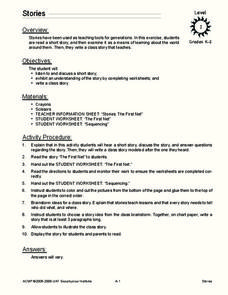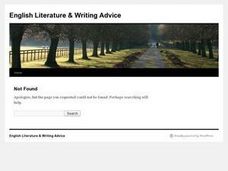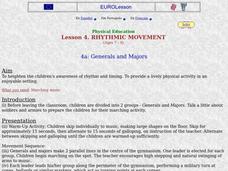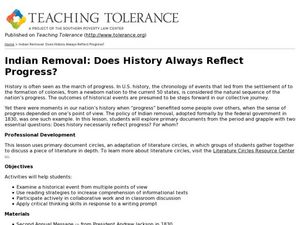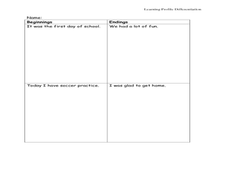Curated OER
Small and Large Squares
Young mathematicians classify squares according to attributes. They sort squares according to specific attributes. Students explore squares in repeating patterns and order squares according to size. Engaging extension activities are...
Curated OER
Stories
Read, discuss, and write short stories with your primary class. They read a short story and complete worksheets for the story. They also brainstorm ideas for a class story and choose an idea to write 3 ideas and then write the story as a...
English Resources
Buddy by Nigel Hinton
The lessons that come from reading the novel Buddy by Nigel Hinton might be masked by how much you have just enjoyed the story, but don’t let an opportunity for learning pass you by. Let this learning scheme bring clarity to the ideas...
Curated OER
Pebbles, Sand and Silt -- Categorizing Fiction and Informational Books
Primary readers complete the activities in a Pebbles, Sand and Silt FOSS kit. As a class, they are given a group of rocks and they are to categorize them based on their activities in the FOSS kit. They use this information and apply it...
Curated OER
Reading Meet Writing
Thinking about introducing your middle schoolers to reading log journals? Try the approach suggested by this resource. After reading to the class an article or portion of a novel, demonstrate a Think Aloud and then model how to transform...
Curated OER
Publication
This lesson was designed in response to a class struggling with Le Petit Prince. The author starts the day by having the class describe (in French) the little prince and his planet. Then, they discuss the use of a dictionary and a list...
Curated OER
Social Studies: Personal Chronology
Fourth graders draw ten significant events from their lives on index cards, shuffle them, and trade sets with other students. Their classmates try to place them in chronological order. Next, 4th graders tape their index cards next to...
Curated OER
Theatre Lesson Plan: Finding Your Way
Second graders identify story elements in familiar stories from their lives. For this story elements lesson, 2nd graders act out familiar activities by following directions. Students read a story and discuss the story elements. Students...
Curated OER
A Hodgepodge of Literature
Students complete multiple lessons to study various literature including poetry, fiction, tall tales, and phrases. In this literature lesson, students complete six lessons about poetry, fiction, and idioms.
Curated OER
Paragraph Writing
Third graders write paragraphs. For this paragraph lesson, 3rd graders discover the parts of a paragraph as they are compared to the pieces of a sandwich. They write their own paragraph to a foreign pen-pal describing our country.
Curated OER
Picture This!
First graders watch the teacher model how to draw pictures and write words in a First, Next, Then, Last - 4 block graphic organizer. They write and draw in their own 4 block papers.
Curated OER
Story Quilts-For the Classroom
Students create a classroom story quilt. In this literacy lesson, students recall events from a text and illustrate their favorite part of the story on a quilt piece. The quilt is sewn together to form a classroom quilt.
Curated OER
Pathways
Students are introduced to how to use a flow diagram. As a class, they brainstorm all of the steps to a specific task and discuss the importance of completing them in the correct sequence. They read books that have an alternate ending...
Curated OER
Rhythmic Movement
Students complete activities to learn about rhythm. In this rhythm and movement lesson, students role play a marching activity in groups. Students listen to music and move according to decorations. Students march in formations to learn...
Curated OER
Dictionaries
Students understand the way the dictionary is laid out as well as the purpose for why people use dictionaries. In this language arts lesson, students recognize the need for alphabetical order and are able to find words using a...
Curated OER
Of Mice and Men: Viewing Guide
In this Of Mice and Men viewing guide worksheet, students study movie terminology as they read brief descriptions and respond to 26 short answer questions as the watch the film based on Steinbeck's novel.
Curated OER
Indian Removal: Does History Always Reflect progress?
Young scholars explore the idea that progress for some might not mean progress for all. In this Native American lesson, students recognize different viewpoints about historical events through the study of primary documents. Young...
Curated OER
Explanation
Walk your class through the process of writing an explanation using this resource. Learners often have to write a how-to explanation for such simple tasks as making a peanut butter sandwich. This presentation identifies key components of...
Curated OER
Cuentos
Students revise Spanish mystery stories. They sequence the events from a group's mystery story and suggest revisions for the setting. They revise their stories using the suggestions from classmates and describe characters in folktales....
Curated OER
Which Way? Ordering Story Events
In this event ordering worksheet, students read a short story, then correctly order a given series of events from the story. Worksheet contains a link to additional activities.
New York City Department of Education
Geography and Early Peoples of the Western Hemisphere
Young historians discover the early people of the western hemisphere. The unit explores how the land changed, how it was used and homes of early Americans such as Incas, Mayans, Inuits, Aztecs, and Pueblos. Individuals also examine these...
Curated OER
If You Give a Pig a Pancake - P is for Pancakes!
Students read "If you give a pig a pancake" then write the letter P with pancake batter on a griddle tablet for a yummy treat to eat!
Curated OER
Harmony and Expression in Writing Form
How do you write an interesting beginning, middle, and end of a story? With this lesson, young writers look to other stories as examples. Then, they use some of the attached graphic organizers to help them create their own story. Note:...
Curated OER
Nursery Rhyme
After reading several types of informational and narrative text involving Nursery Rhymes, have your young readers create a dramatic reading of their selected tale to perform for the class.



